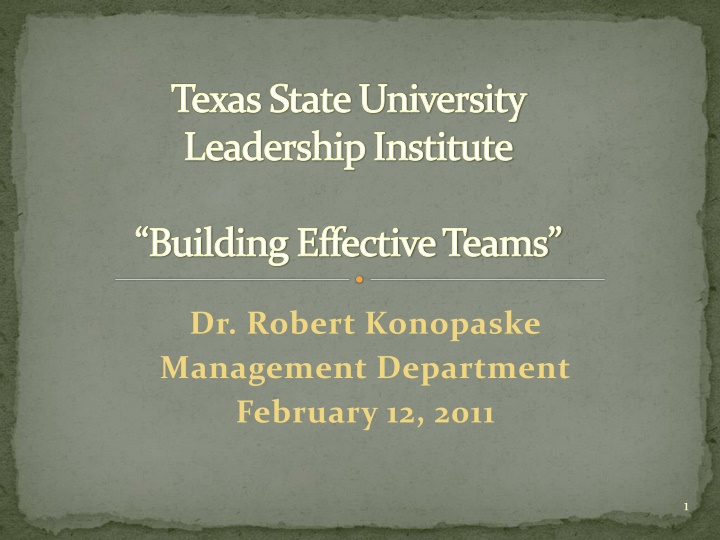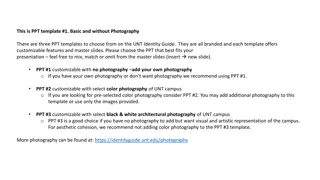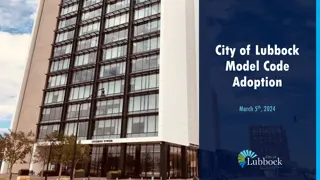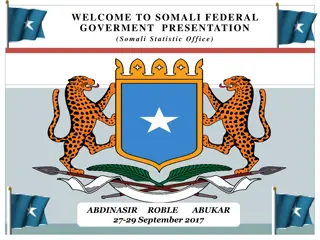
Building Effective Teams in Organizations
This resource covers the importance of teams in the workplace, advantages and disadvantages of working in teams, reasons why people withhold effort in teams, when to use teams effectively, and the continuum of autonomy in work groups. It also introduces the concept of self-designing teams and discusses virtual teams as a special type of team. The content emphasizes the benefits of teamwork for enhanced productivity, decision-making, and job satisfaction, while also highlighting potential challenges such as social loafing and groupthink.
Download Presentation

Please find below an Image/Link to download the presentation.
The content on the website is provided AS IS for your information and personal use only. It may not be sold, licensed, or shared on other websites without obtaining consent from the author. If you encounter any issues during the download, it is possible that the publisher has removed the file from their server.
You are allowed to download the files provided on this website for personal or commercial use, subject to the condition that they are used lawfully. All files are the property of their respective owners.
The content on the website is provided AS IS for your information and personal use only. It may not be sold, licensed, or shared on other websites without obtaining consent from the author.
E N D
Presentation Transcript
Texas State University Leadership Institute Building Effective Teams Dr. Robert Konopaske Management Department February 12, 2011 1
Get ready for teamwork! Teams can make magic! http://www.youtube.com/watch?v=TzNACAG74QA U.S. organizations use teams for a variety of reasons 80% of companies with more than 100 employees use teams 90% of all U.S. employees work part of their day in a team Chances are you ll be a member of one (or more) teams at your work! 2
Advantages of teams Improved customer satisfaction Improved product & service quality Increased speed & efficiency Higher job satisfaction Better decision making More creative problem solving 3
Disadvantages of teams Initially high employee turnover Social loafing Lowered quality of group decision making Groupthink Inefficient meetings Domination by a few members Lack of accountability 4
Why people withhold effort in teams The presence of someone with expertise The presentation of a compelling argument Lacking confidence in one s ability to contribute An unimportant or meaningless decision A dysfunctional decision-making climate Again, social loafing can be an issue 1. 2. 3. 4. 5. 6. 5
Continuum of autonomy in work groups Self- designing Teams Self- managing Teams Semi- autonomous Work Groups Employee Involvement Groups Traditional Work Groups Autonomy 7
Self-designing Teams Same as self-managing teams except: Control and change design of team Control resources for task accomplishment Impose discipline on team members: Hire and fire Divide rewards Decide on penalties (ex: tardiness) Can change task of team 8
Special type of team: Virtual Geographically and/or organizationally dispersed coworker who use telecommunication & IT to accomplish an organizational task Tips for creating successful virtual teams: Select self-starters and strong communicators Keep the team focused on clear, specific goals Provide frequent feedback Periodically bring team members together & use team building Improve communications & ask team members for feedback on how well team is working 9
Work team characteristics Team Norms Team Cohesiveness Team Size Team Conflict Team Development 10
Team norms Informally agreed-on standards that regulate team behavior Powerful influence on work behavior Regulate the everyday behaviors of teams e.g., soldiering 11
Team cohesiveness The extent to which members are attracted to the team and motivated to remain in it Cohesive teams: retain their members promote cooperation have high levels of performance Promote team cohesiveness by: Make sure all team members are present at team meetings Create additional opportunities for teammates to work together 1. 2. Engage in nonwork activities as a team Make employees feel that they are part of a special organization 3. 4. 12
Team size & performance: A U-shaped relationship Performance Team Size (6-9 members) 13
Team conflict C-type Conflict cognitive conflict focuses on problems and issues associated with improvements in team performance A-type Conflict affective conflict emotional, personal disagreements associated with decreases in team performance Both types often occur simultaneously 14
Team Development: Stages Forming 1st stage of team development; get to know other members; set ground rules Storming 2nd stage; conflict over what should be done & how to do it; team leader nudges group toward team goals Team will be ineffective if it gets stuck here Norming 3rd stage; informal rules; members get used to roles; group cohesion grows Performing 4th stage; performance high b/c team has matured; it s fully functioning now 15
Types of team training Interpersonal Skills Decision Making and Problem Solving Conflict Technical Training Training for Team Leaders 16
Causes of Unproductive Teams Power struggles Individual behavior Unequal Workload Lack of top management support Poor leadership Lack of focus Capability issues Groupthink http://www.youtube.com/watch?v=qYpbStMyz_I 17




















